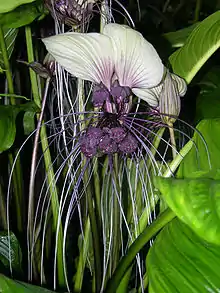Tacca integrifolia
Tacca integrifolia, the white batflower, is a species of flowering plant in the yam family, Dioscoreaceae, native to tropical and subtropical rainforests of Central Asia. It was first described by the English botanist John Bellenden Ker Gawler in 1812.
| White batflower | |
|---|---|
 | |
| Scientific classification | |
| Kingdom: | Plantae |
| Clade: | Tracheophytes |
| Clade: | Angiosperms |
| Clade: | Monocots |
| Order: | Dioscoreales |
| Family: | Dioscoreaceae |
| Genus: | Tacca |
| Species: | T. integrifolia |
| Binomial name | |
| Tacca integrifolia Ker Gawl., 1812 | |
| Synonyms[1] | |
| |
Description
Tacca integrifolia is a herb growing from a thick, cylindrical rhizome. The leaf blades are borne on long stems and are oblong-elliptical to oblong-lanceolate, some 50 by 20 cm (20 by 8 in), with tapering bases and slender pointed tips. The flower scape is about 55 cm (22 in) long and is topped with a pair of involucral bracts, broad and erect, white with mauve venation. Among the individual nodding flowers, which are arranged in an umbel, are further long, filiform (thread-like) bracts. The perianth of each flower is tubular and purplish-black, 1 to 2 cm (0.4 to 0.8 in) long, with two whorls of three perianth lobes, the outer three narrowly oblong and the inner three broadly obovate. The fruits are fleshy berries some 2 cm (0.8 in) long, and the seeds, which have six longitudinal ridges, have the remains of the perianth lobes still attached.[2][3]
Distribution and habitat
The species is native to hilly regions of tropical and subtropical central Asia. It is known from Pakistan, eastern India, Sri Lanka, Bhutan, Bangladesh, Nepal, Myanmar, Malaysia, Thailand, Cambodia, Vietnam and eastern China.[2] It grows in the understorey of humid rainforests, growing in the leaf litter in shady sites.[4]
Ecology
The stamens are attached to the tube of the perianth in a helmet-like manner and, with the flat-topped stigma lobes, may form an insect trap; a sweet musky odour has been detected from these flowers and this may attract flies as pollinators. After pollination, the scape bends over and the developing fruits rest on the ground. The fleshy fruits are a dull colour with soft jelly-like pulp, and it is possible that the seeds are dispersed by rodents and other small mammals as they feed on the fruits.[3]
References
- "Tacca integrifolia Ker Gawl.". World Checklist of Selected Plant Families (WCSP). Royal Botanic Gardens, Kew. Retrieved 17 June 2017 – via The Plant List.
- Wiart, Christophe (2006). Medicinal Plants of the Asia-Pacific: Drugs for the Future?. World Scientific. pp. 688–689. ISBN 978-981-4480-33-8.
- Klaus Kubitzki (2013). Flowering Plants. Monocotyledons: Lilianae (except Orchidaceae). Springer Science & Business Media. pp. 425–427. ISBN 978-3-662-03533-7.
- "Tacca integrifolia". Plants Rescue. Retrieved 18 March 2017.
External links
 Media related to Tacca integrifolia at Wikimedia Commons
Media related to Tacca integrifolia at Wikimedia Commons Data related to Tacca integrifolia at Wikispecies
Data related to Tacca integrifolia at Wikispecies